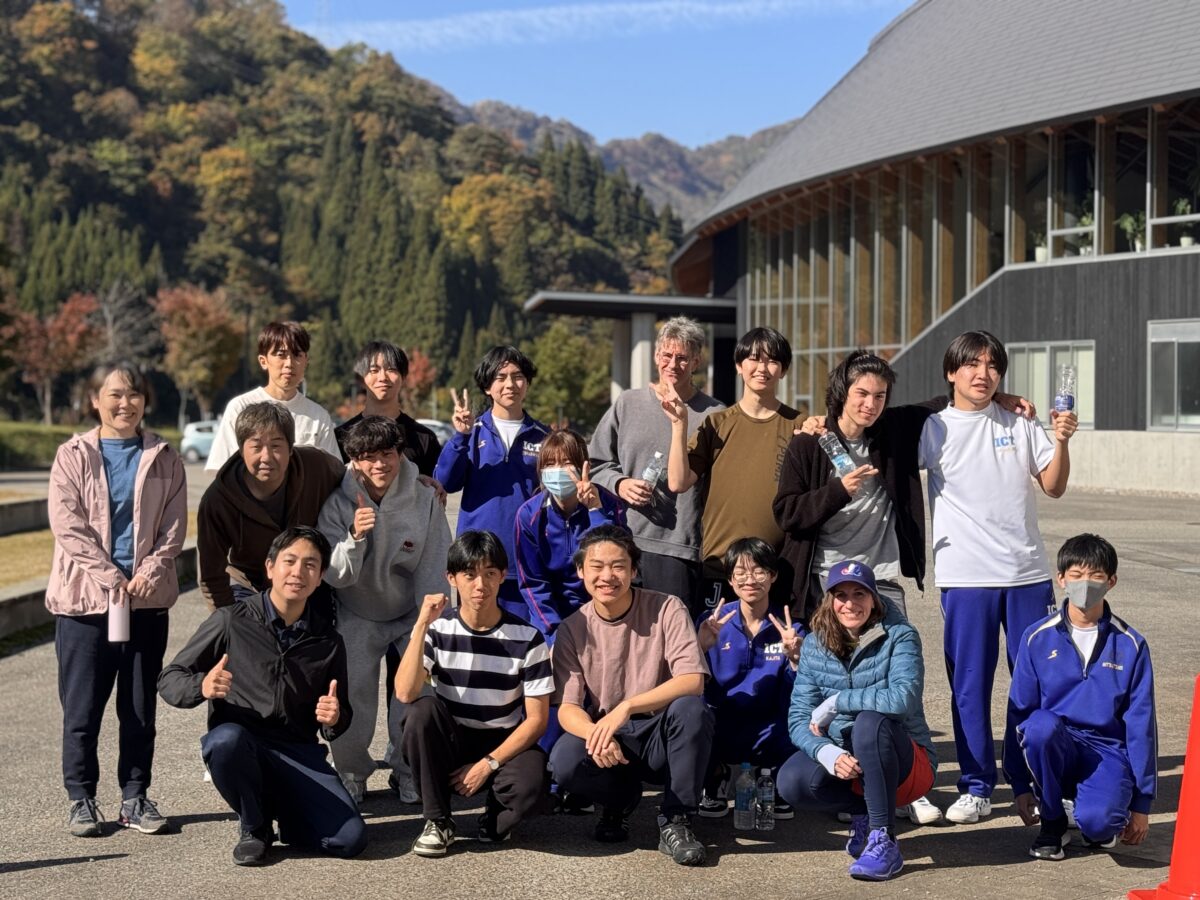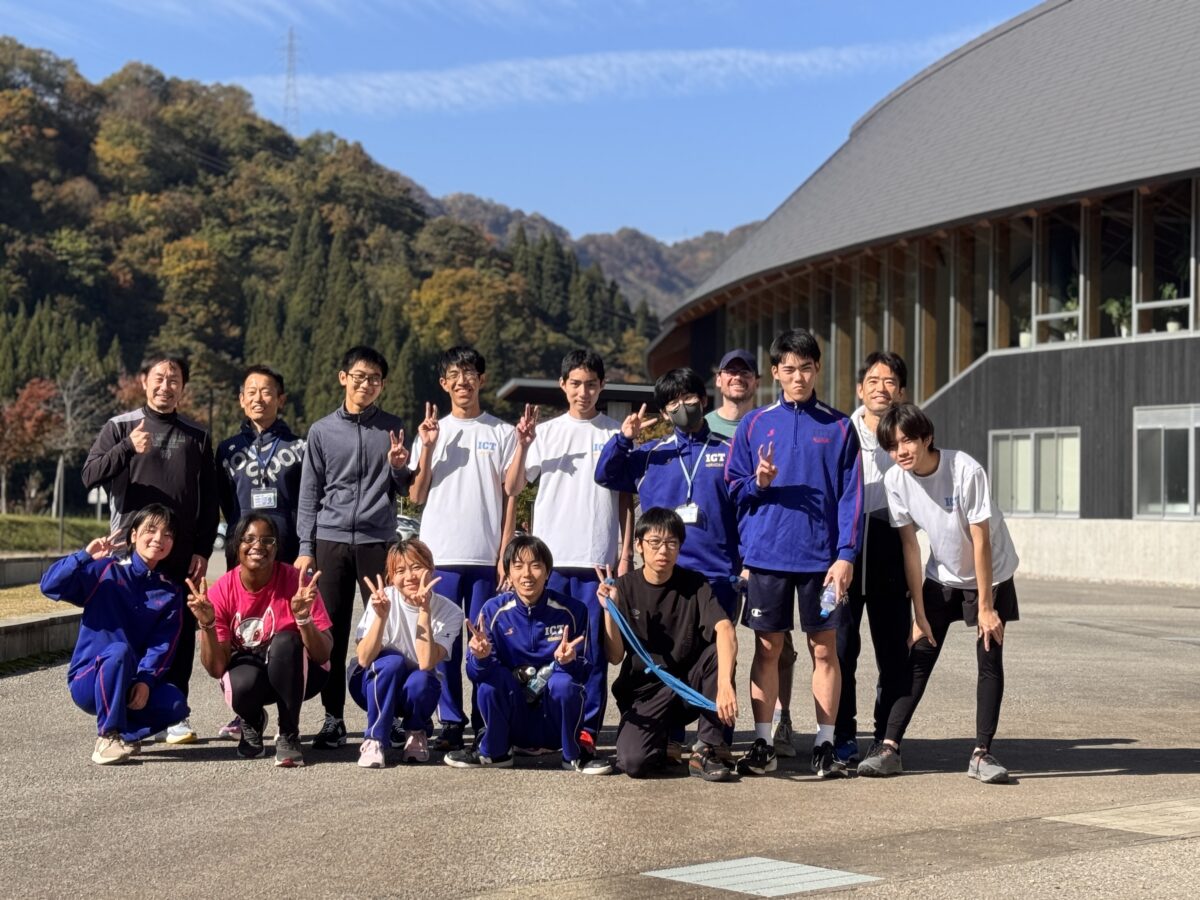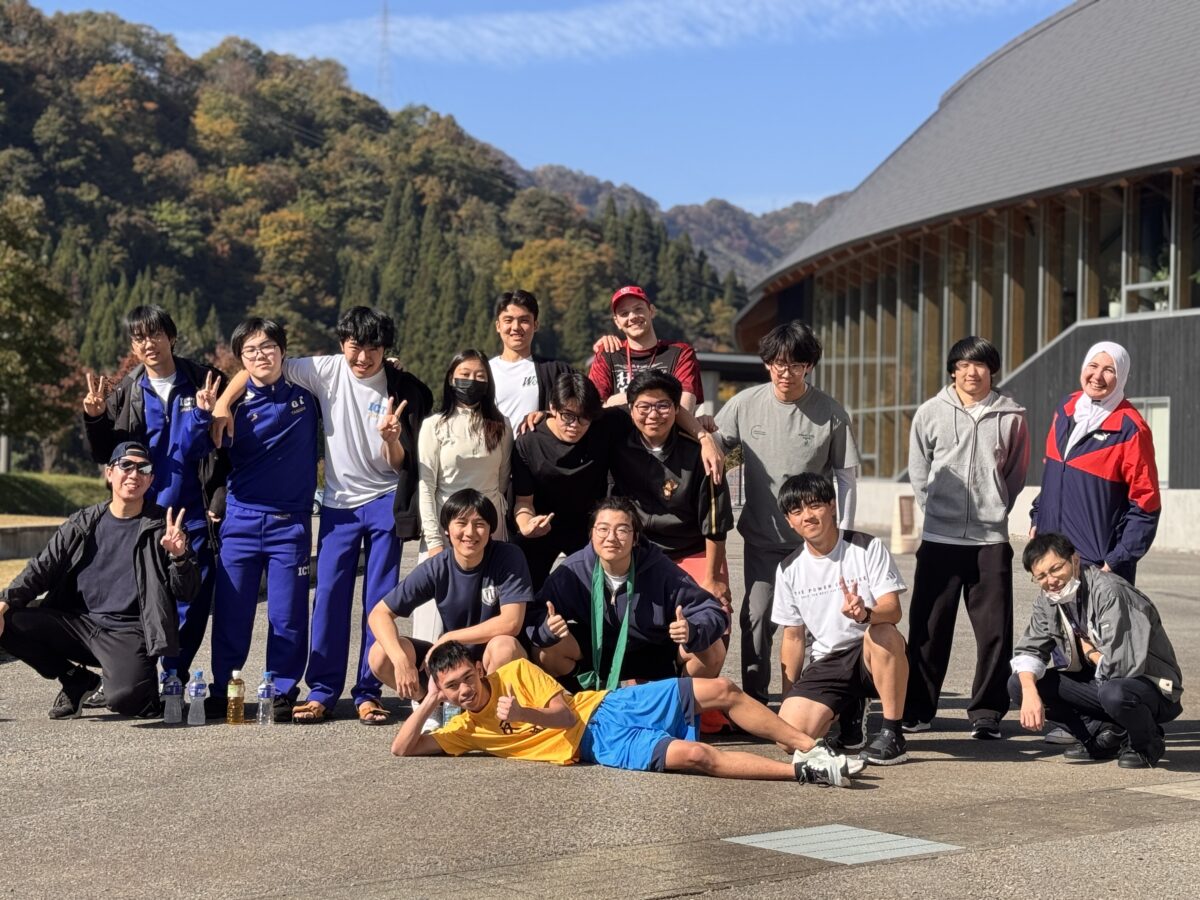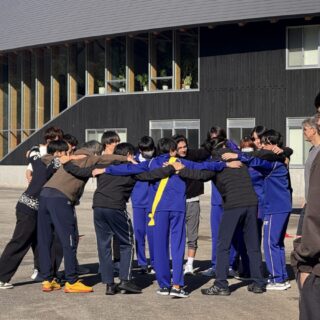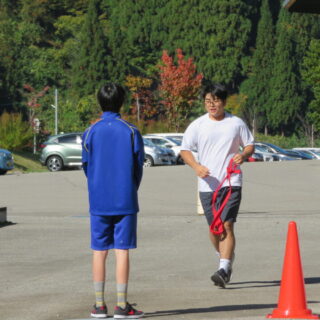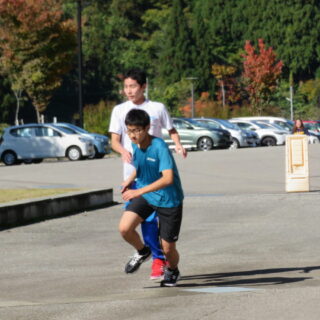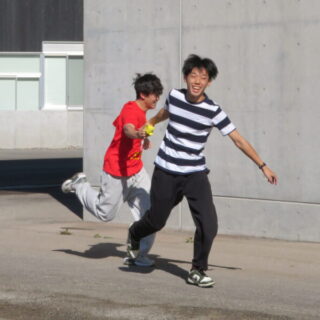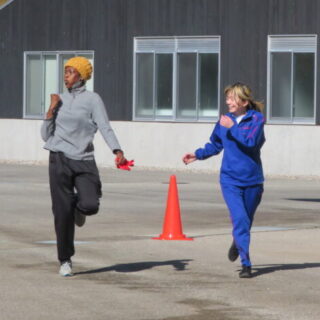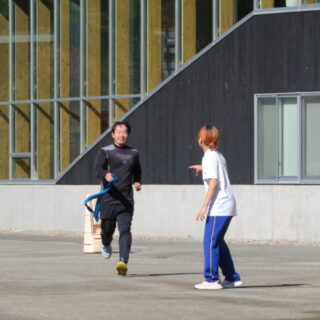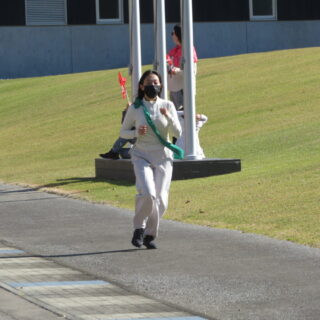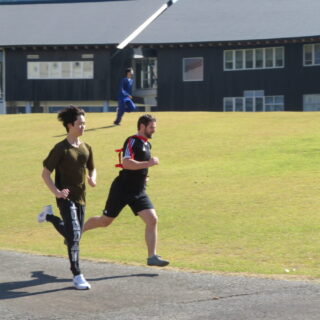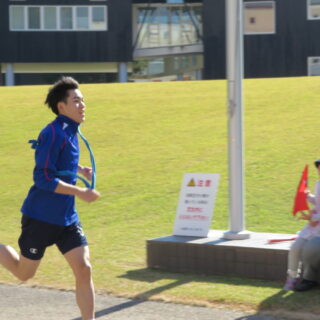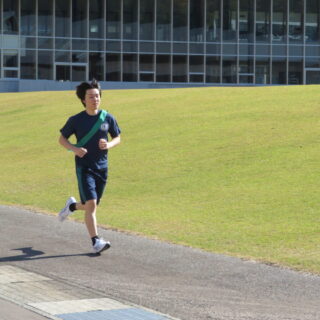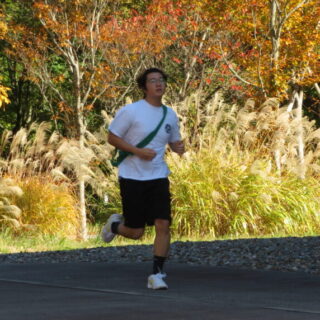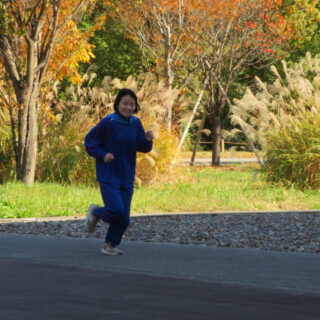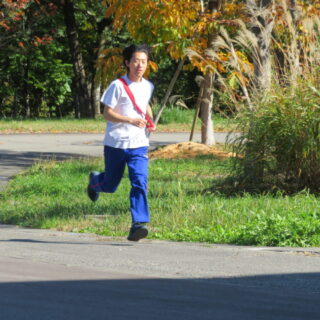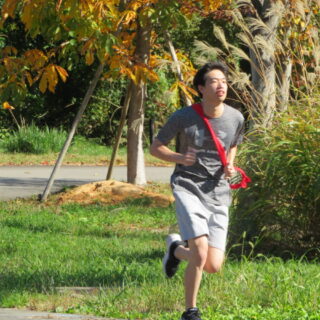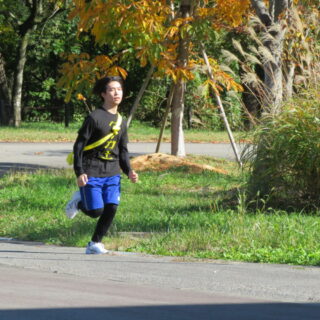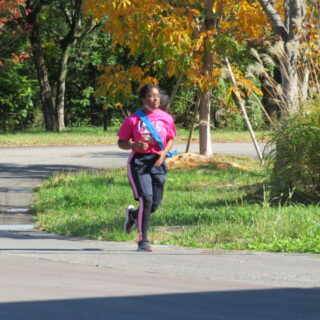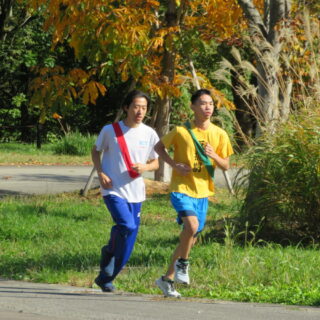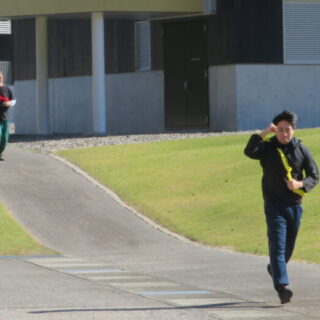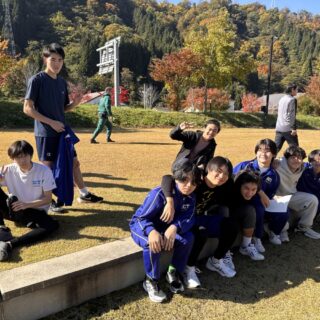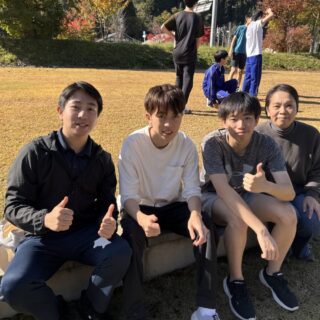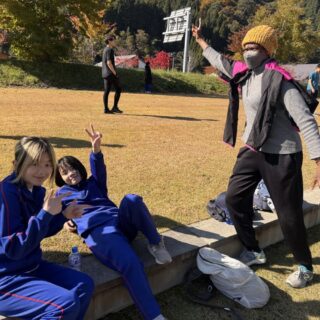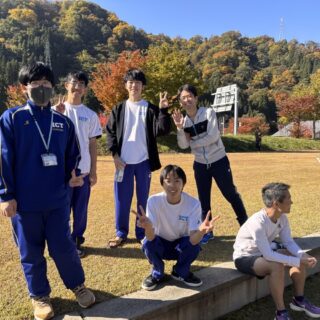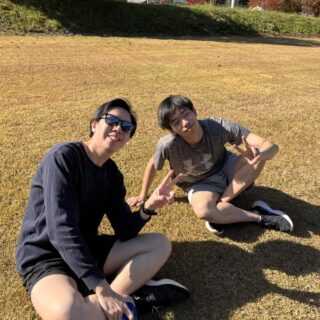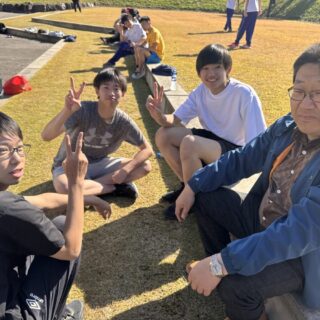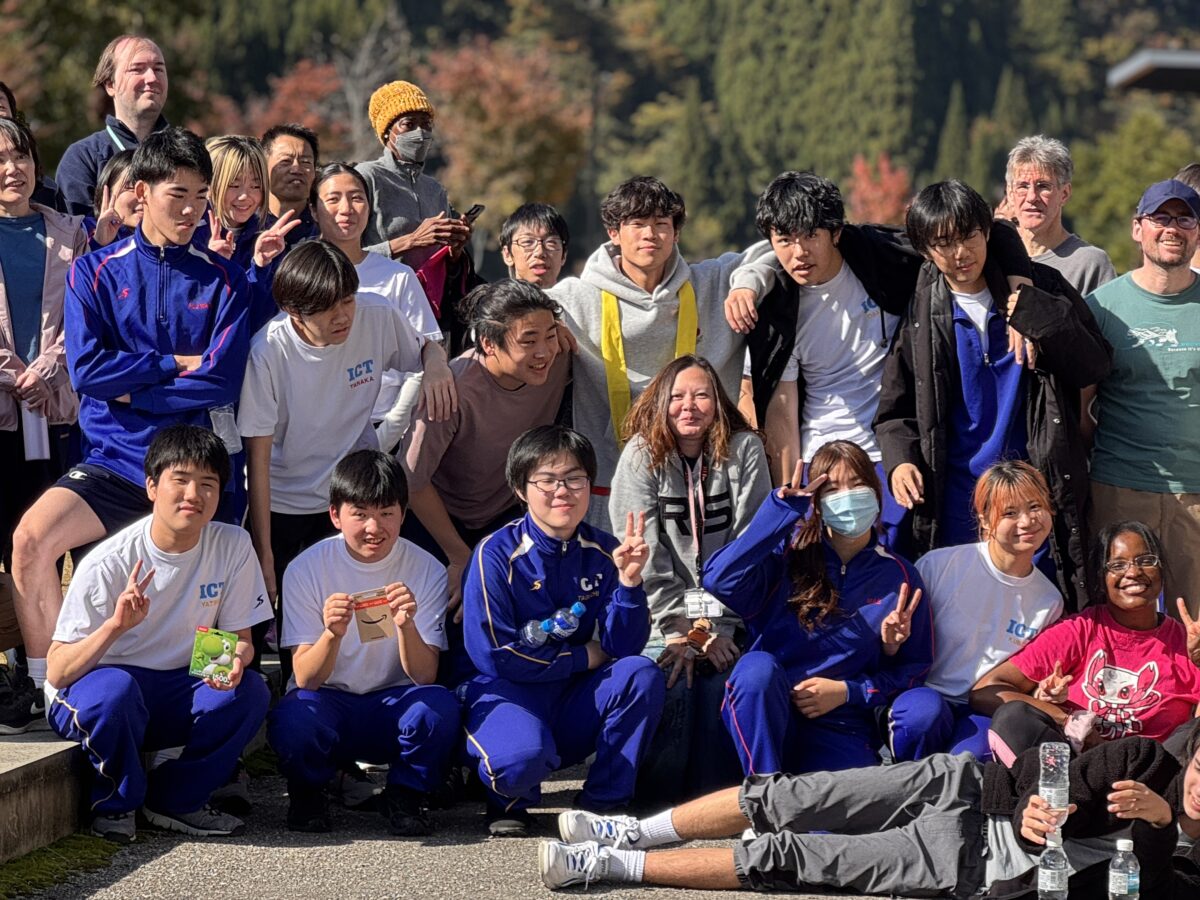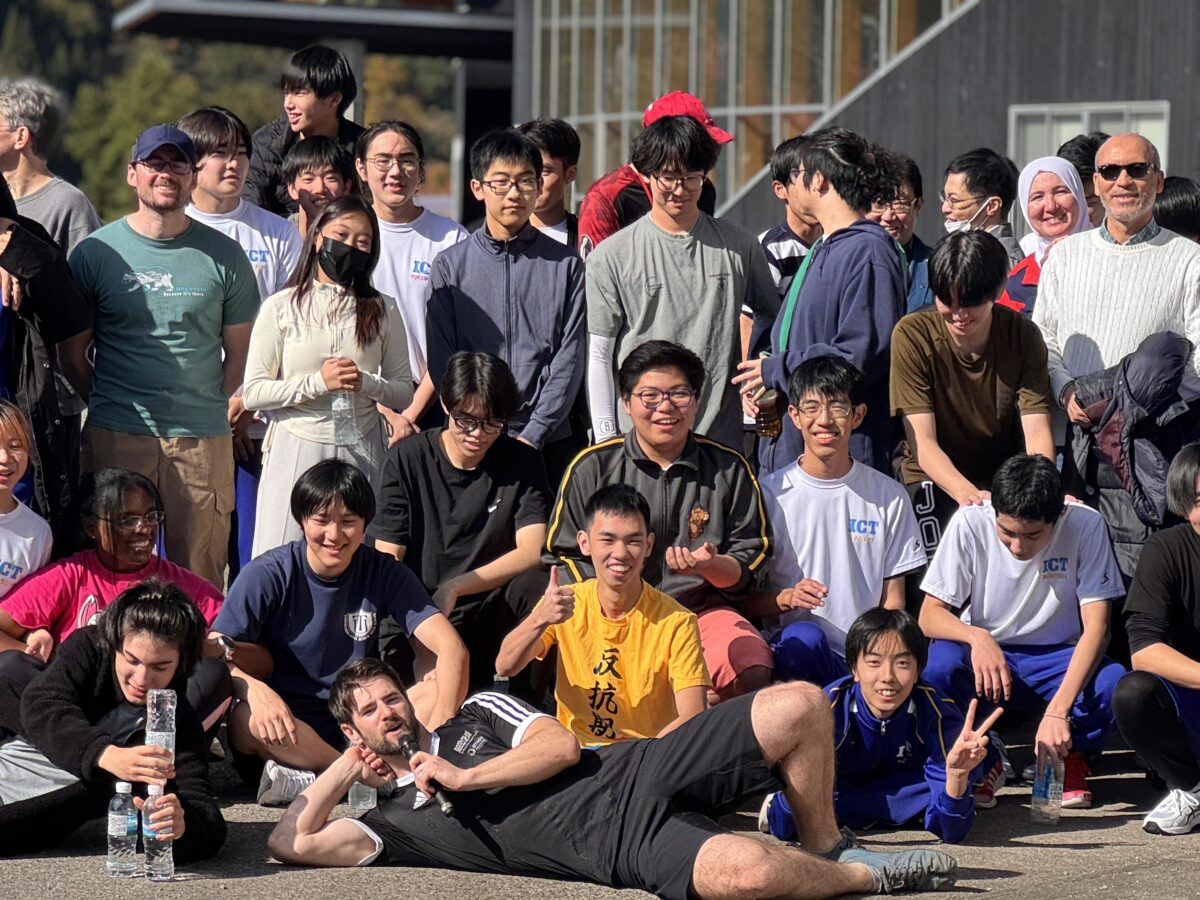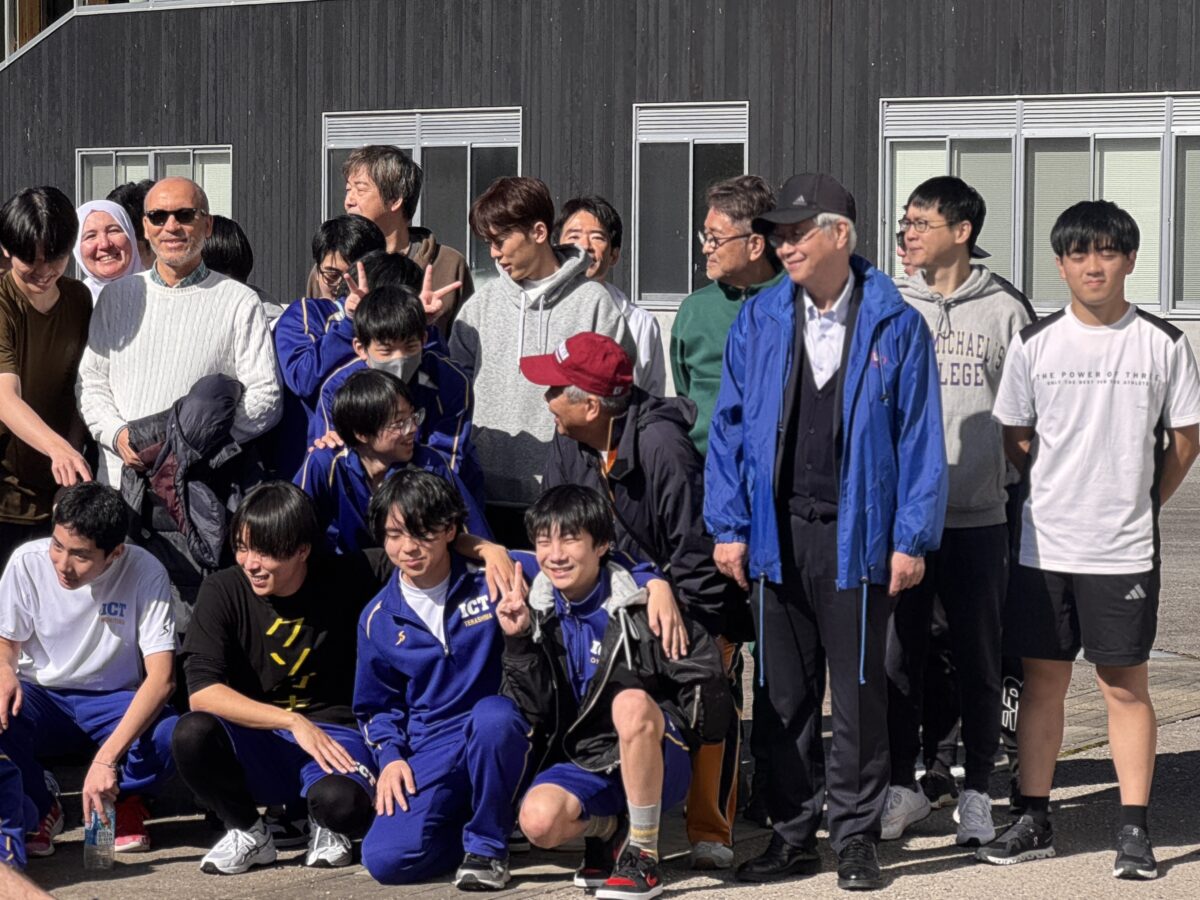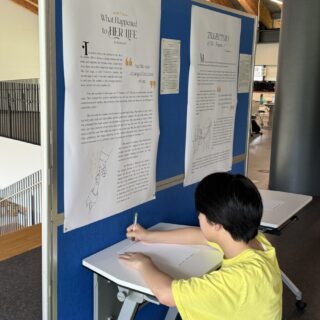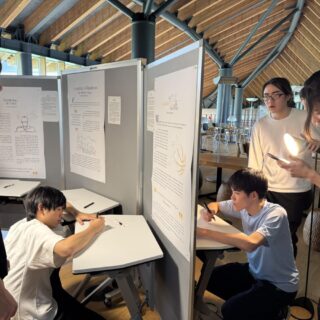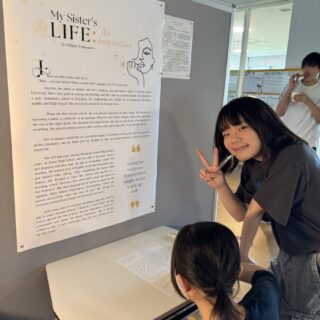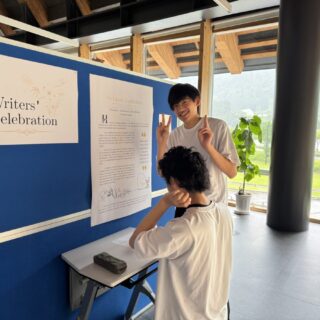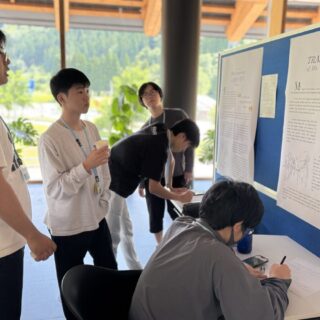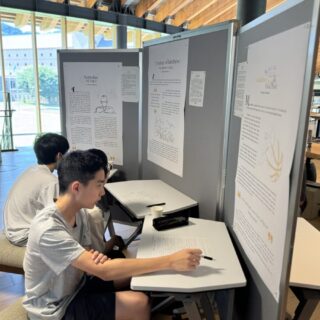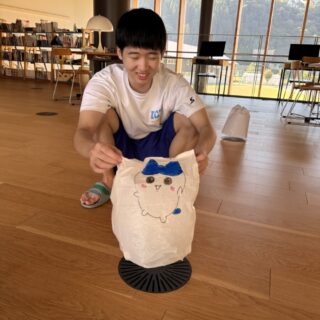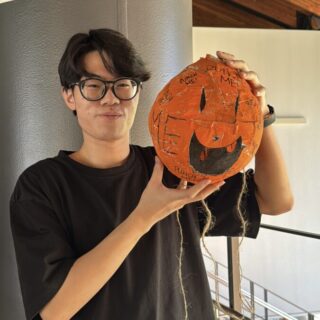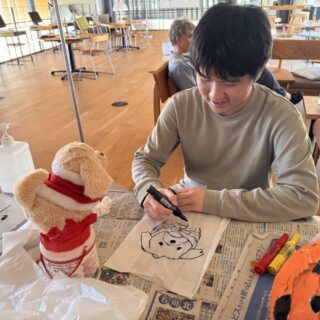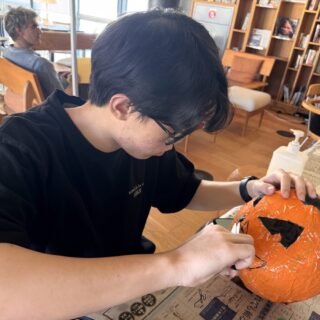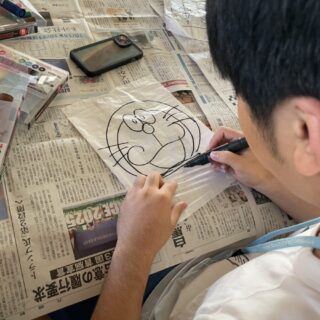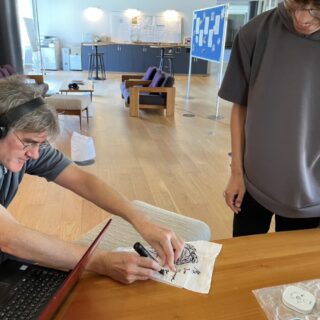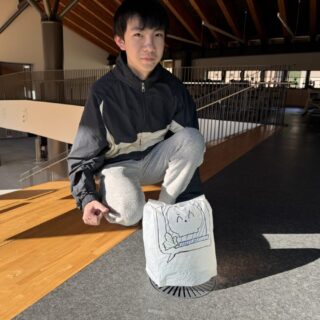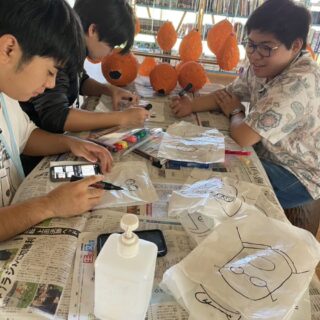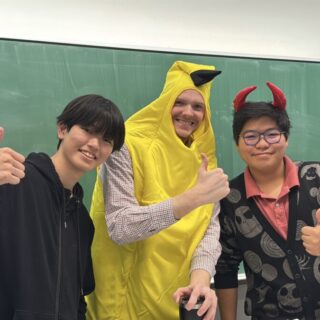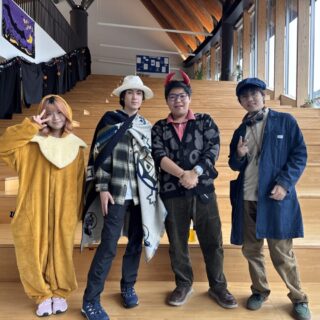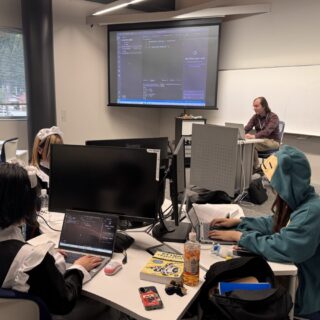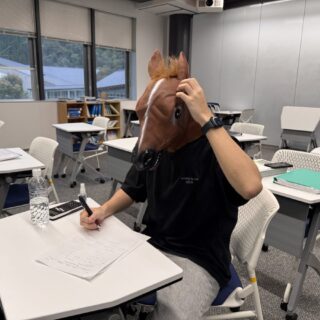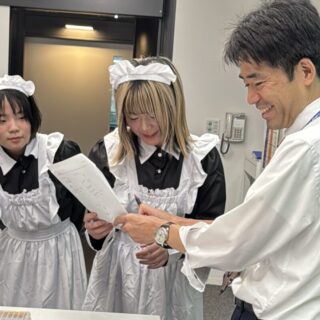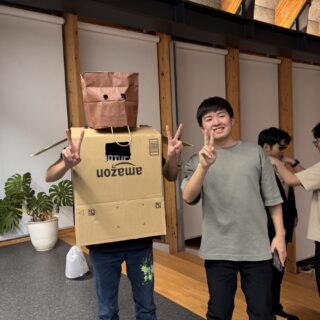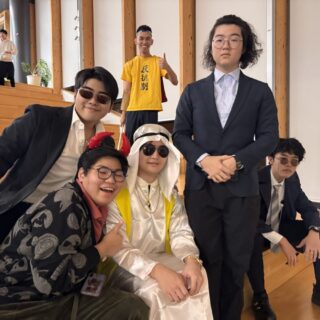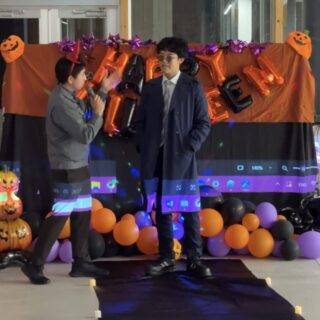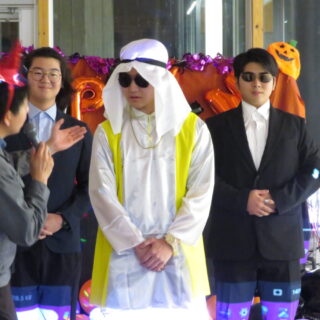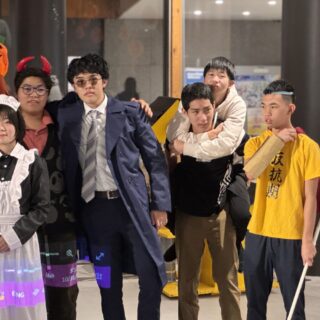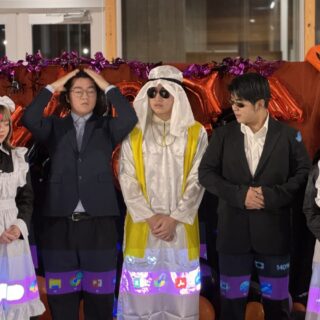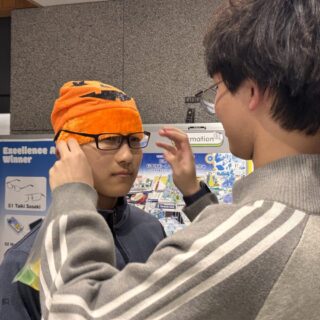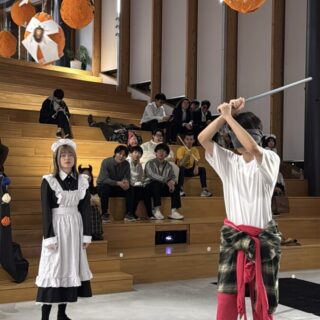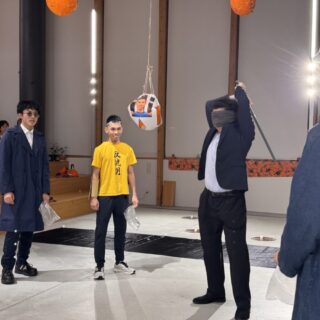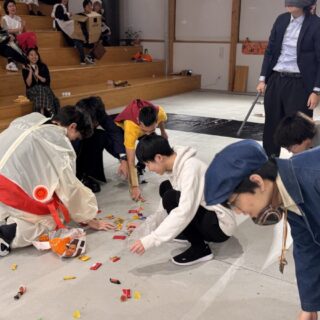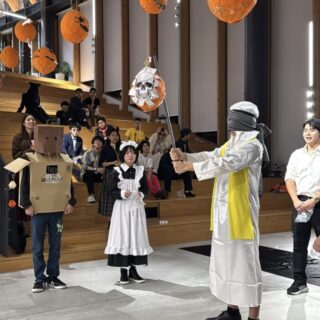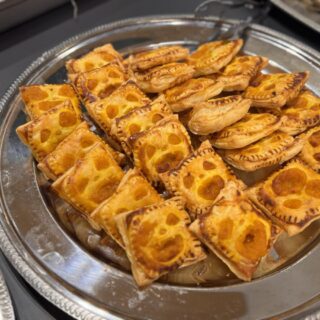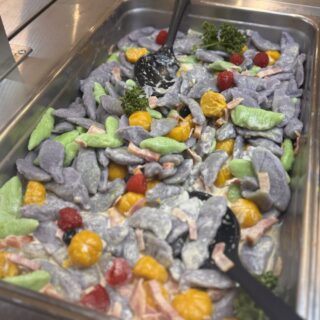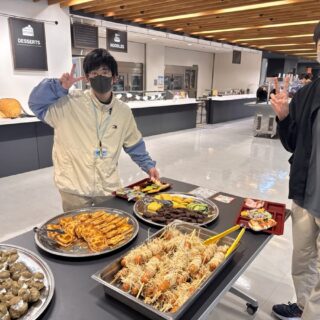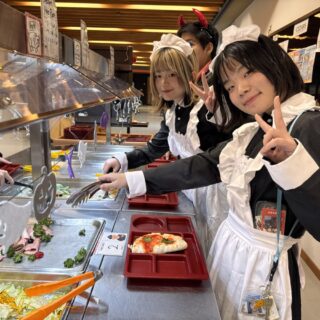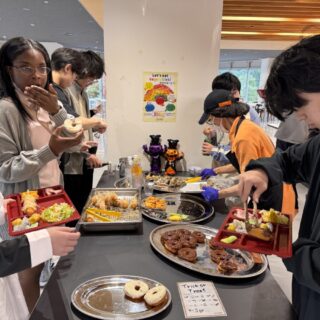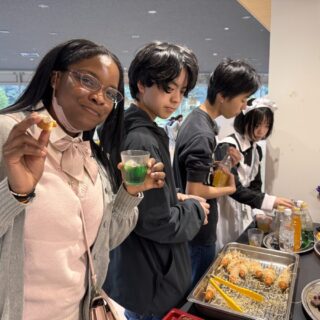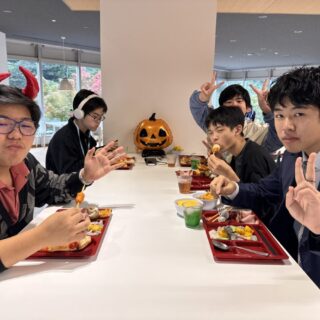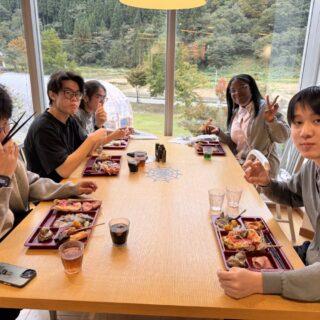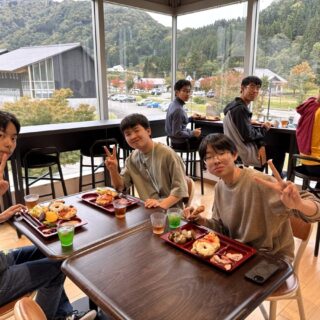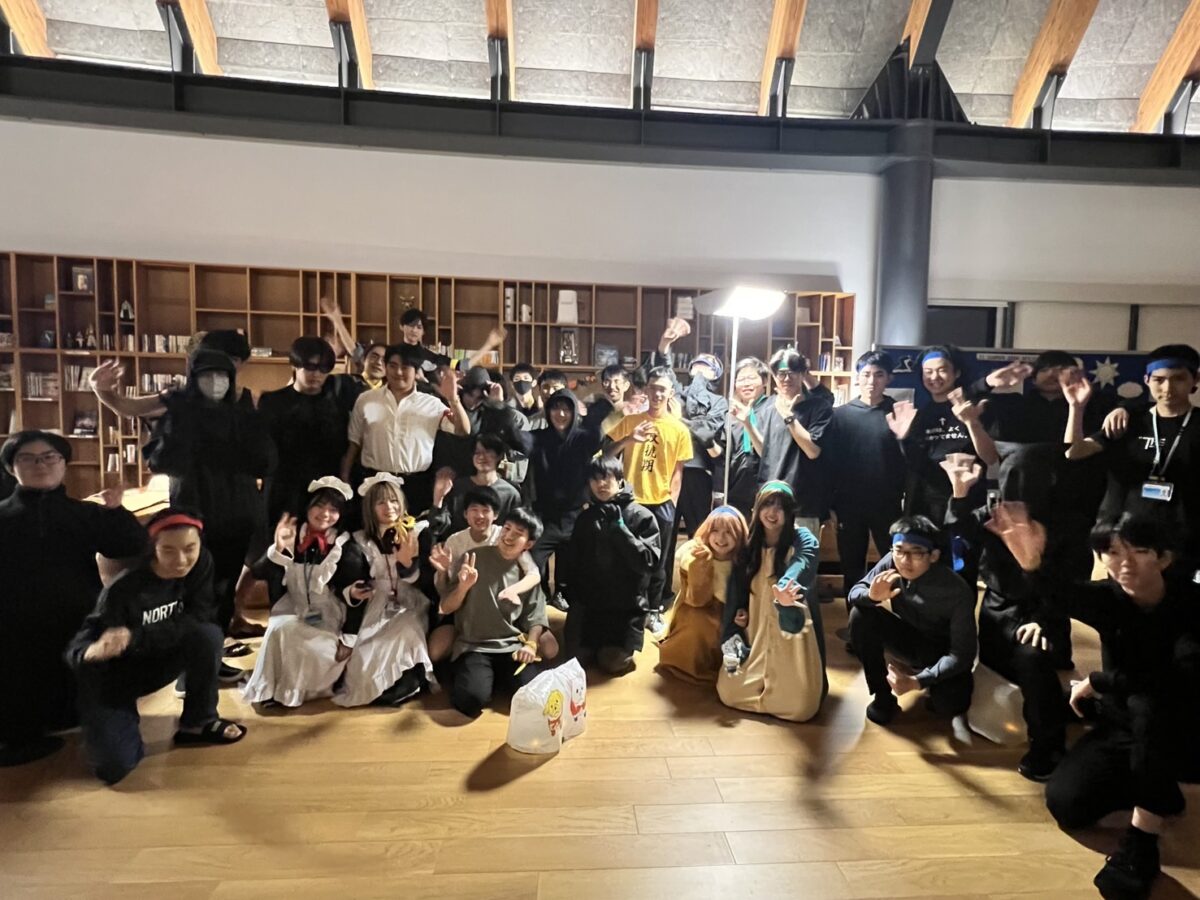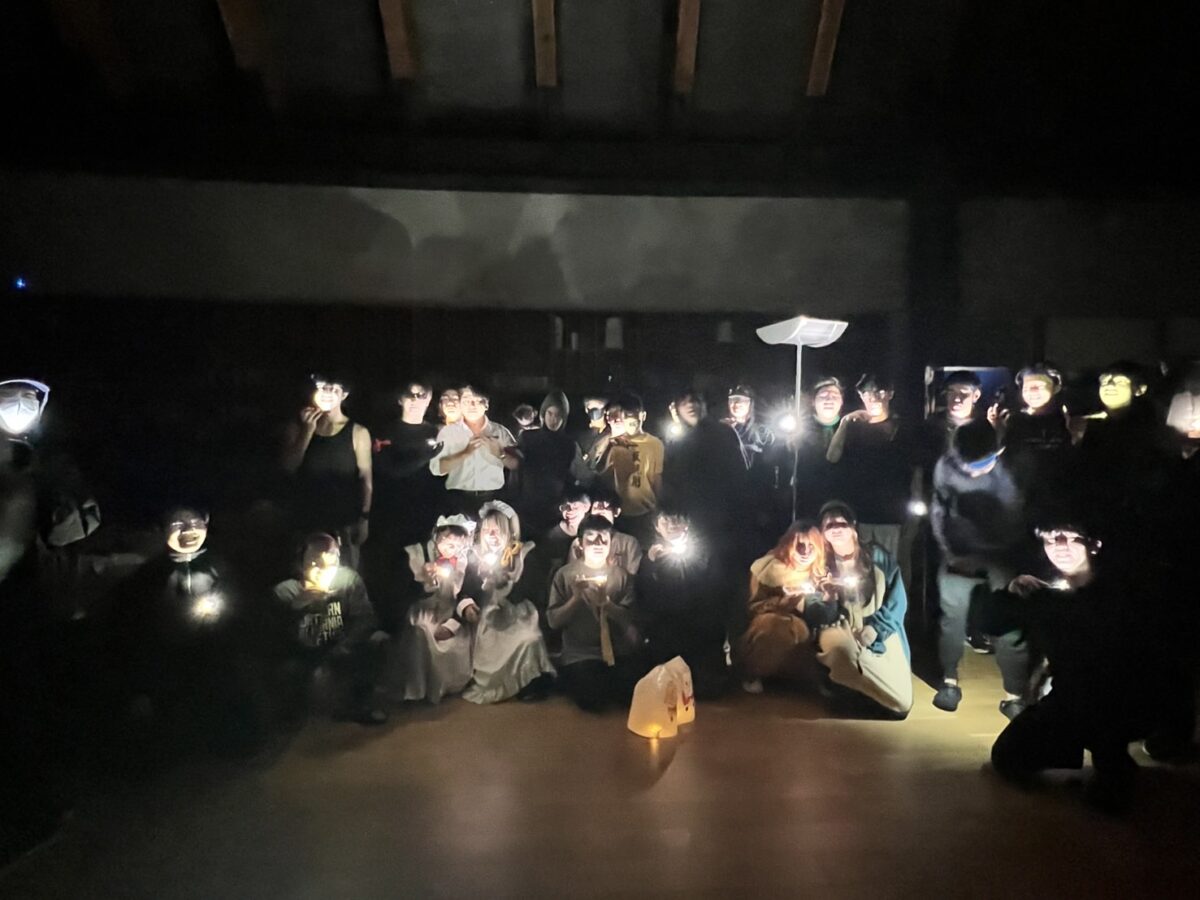FY 2025
2025年度の記事
 白山麓キャンパスで保健・体育科目を担当しているフィリップ・ケザウです。2025年11月8日(土)、白山麓キャンパスでは「第2回チーム対抗駅伝大会」が行われました。レースの目的は、15名で構成された各チームがキャンパス周回コース(1周約670m)を合計25周走り切ることでした。チームは学年を超えて編成され、教員も参加しました。
白山麓キャンパスで保健・体育科目を担当しているフィリップ・ケザウです。2025年11月8日(土)、白山麓キャンパスでは「第2回チーム対抗駅伝大会」が行われました。レースの目的は、15名で構成された各チームがキャンパス周回コース(1周約670m)を合計25周走り切ることでした。チームは学年を超えて編成され、教員も参加しました。
目標は最速でゴールすることではなく、事前に予想したタイムに最も近いタイムで完走することでした。このルールは少し複雑に感じるかもしれません。通常の「最速チームが勝ち」という形式よりも確かに複雑です。しかし、この方式を選んだ理由はいくつかあります。急激な運動による怪我のリスクを減らすこと、速くない学生へのプレッシャーを軽減すること、そして教員が「チームを遅らせてしまう」という負担感なく参加できるようにするためです。
3チームが100分を予想タイムに設定し、1チームだけが86分と予想しました。当日は天候に恵まれ、雲ひとつない青空に紅葉の色が映える最高の日でした。涼しい風が吹き、まさに秋晴れの中での開催です。全員が整列し、学年を超えたチームに分かれた後、4年生の古元 柚希さんが素晴らしいスピーチをしてくれました。このイベントは学年間の交流の機会であること、そして1年生に対して「上級生は大きくて威圧感を感じるかもしれないけれど、怖がらずに話しかけてほしい」と励ましていました。
カウントダウンの後、チームは一斉にスタート!本来はペースを予測するゲームのはずが、当日の高揚感で全員が全力疾走。最初の8周は、わずか25分で走り終えてしまいました。まだ時間は十分あるのに、みんな全力です。そこで急遽、目標タイムを調整し、最終的には「80分に最も近いチーム」が勝者というルールに変更しました。
このイベントで最も印象的だったのは、学年間の雰囲気の良さです。応援の声が飛び交い、終始楽しい空気に包まれていました。私は運動が大好きですが、走ることに苦手意識を持つ学生も多いので、このように楽しく盛り上がる雰囲気はとても嬉しかったです。
その中、イアン・スティーブンソン先生は自分の順番以外でもずっと走り続けました。学生たちの間で、「イアン先生は何周走った?」という即興のクイズも始まり、彼の走り続ける姿は観客にとって刺激になっていました。レースは続き、タスキの受け渡しごとに歓声が上がり、誰もが主役になれる瞬間がありました。残念ながら、昨年同様に足首や呼吸がしづらい症状を訴えた参加者がいましたが、その人数は昨年より少なく、自覚症状のレベルですみました。最後の周回が終わり、結果は驚くほど接戦!時計やスマホで時間を確認できない中、全チームが目標の80分以内に10分差で収まりました。
結局、タイム目標方式はゴールの瞬間の盛り上がりには欠けましたが、怪我は減り、教員の参加も増え、学生にとっても競争のプレッシャーが少ない楽しい一日になりました。来年はどうなるでしょうか?スピードを重視する「競技形式」に再び魅力を感じるかもしれません。でも、今年は素晴らしい天気と素敵な仲間に恵まれ、キャンパスが分散している中で、このようなイベントが社会的なつながりを保つために重要だと改めて感じました。
フィリップ・ケザウ

This is Philip Cadzow, one of the Physical Education Teachers on ICT’s Hakusanroku Campus. On Saturday, November 8th, 2025, the second annual Ekiden (a team relay race) was held at Hakusanroku Campus. The goal of the race was for each team of 15 members to complete 25 laps around the campus (roughly 670 m per lap). The teams were composed of students from different year levels and teachers.
The objective was not to finish in the fastest time, but to be the team that completed the laps in a time closest to their estimate. This goal system may sound confusing and overly complicated; it is certainly more so than the usual “fastest team” approach. This design was chosen for several reasons: to reduce the risk of student injuries from sudden intense movement, to relieve pressure on those who were not as fast as others, and to allow more teachers to participate without feeling bad about slowing down a team.
Three of the teams chose 100 minutes as their estimated time, and only one team guessed that they would finish in 86 minutes. The day had perfect weather—clear blue skies with only a cooling wind. There were no clouds, only a blue sky contrasting with the changing colors of the leaves. With everyone lined up and mixed into their teams, Yuzuki Komoto—a 4th year student—gave a very nice speech about the event being an opportunity for different year levels to mix socially. He encouraged the 1st year students, saying that while the older students may seem big and intimidating, they should not feel afraid to talk to them.
After a countdown, the teams took off sprinting! What was meant to be a challenge to guess everyone’s pace soon changed with the energy of the day. I did not expect the excitement of running to be so powerful. The first eight laps were finished in only 25 minutes. Everybody was sprinting their fastest, even though they had plenty of time. Therefore, I had to make an emergency adjustment to the times, otherwise everyone would be far off their estimated time! Therefore, the competition was changed to which team managed to get the closest to 80 minutes total time.
I was most impressed with the atmosphere of the event; the feeling was very friendly between all year groups, and there was plenty of cheering and general enjoyment of the day. As much as I love and enjoy movement, sometimes that passion is not embodied in the many different types of students, especially when it comes to running. So, I was very happy that the atmosphere of the day was so joyous and filled with friendly rivalry.
A spontaneous guessing game of “How many laps has Ian-sensei run?” began to develop as well, his insatiable need to run being an inspiration to the watching crowd. The race continued and each changeover was cheered; each person had their time in the spotlight. Unfortunately, this also brought some of the same injuries as last year, with ankles and lungs feeling the pressure—but in fewer numbers than last year, and it was self-inflicted rather than prescribed.
The last laps were run, and the finishing times were very close! Considering that nobody had a watch or phone to keep track of the time, this was very impressive. All teams were within 10 minutes of the 80-minute goal.
In the end, having a time goal rather than a race was less satisfying to watch at the finish, but we had fewer injuries, more teacher participation, and the students had a slightly more relaxed and fun day rather than the pressure of competition. I don’t know what next year will bring—whether the allure of competition will call me back—but this year we had wonderful weather and good people. A lovely reminder that with a separated campus, events like these are important for social bonding.
Philip Cadzow
こんにちは、英語科目担当のポーリン・ベアードです。
今学期、2年生のリーディング・ライティングの授業では、学生たちが「Profile Essay」を書くために、自分にとってインスピレーションを与えてくれる人物にインタビューを行いました。家族について書いた学生も多く、メモを取りながら文章を仕上げていきました。書く過程そのものも価値あるものでしたが、最後に行われた「Writer’s Celebration」で最も重要な気づきがありました。
学生たちは、自分の作品を英語と日本語で掲示板に貼り、他の学生や教職員に披露しました。その様子を見て、私は「家族の物語を書くこと」が、学生たちが作家として、また思考する人としてのアイデンティティを育むための特別な窓(きっかけ)となることに気づきました。
また、Writer’s Celebrationを実施したことで、学生たちが英語で自然に物語を用いながら、自分の価値観を探求できることがわかりました。祖父母や両親について語る中で、共通するテーマ―「優しさ」「強靭さ」「リーダーシップ」「創造性」「感情的な強さ」―が見えてきました。ある学生は、祖父が雨の日に傘を差し出してくれたという小さな行為が、どれほど心に響いたかを語りました。これらの物語は単なる子どもの頃の思い出ではなく、世代を超えて受け継がれる教訓であり、学生自身の声で語られたものです。これを読むと、ライティングは文法や構造だけではなく、「何が大切で、なぜそれが大切なのか」を理解することでもあると改めて感じます。
発表中、学生たちは教員や他の学生たちからのコメントを誇らしげに読みました。自分の人生から生まれた文章だからこそ、彼らはその作品に強い愛着を持っていました。多くの学生が「自分は意味(価値)のある物語を語れる」という発見をし、他の学生たちも「私たちはこんなにも共通点を持っている」ということに気づきました。例えば、ある学生が母親の前向きな姿勢について書いた文章は、別の学生が父親の思いやりについて語った文章と響き合います。学生全員が互いの文章を目にする機会はそう多くありません。だからこそ、こうした共有の時間は、ライティングを皆で分かち合えるものにし、ワークシートのような問題解決学習では決して生まれない一体感を育てます。
教員にとっても、学生がどのように考え、感じ、意思決定をしているかを垣間見る貴重な機会となりました。学生が何を大切にしているのか―友情、努力、優しさ、家族―を知ることで、今後の授業づくりにも役立ちます。
Writer’s Celebrationは、単なる課題を「仲間と価値観を共有できる体験」に変えました。そのことは、学生が自分の物語を語る時、彼らは「自分は書き手である」と認識し、私たち教員も学生をより深く理解できるのです。
【Writer’s Celebration】
一般的に、執筆における成果と努力を称え、作家同士が互いに励まし合うイベントです。学生の文章を発表することで、モチベーションの維持、学びの定着、文章力向上や、仲間や学校コミュニティと喜びを共有することで達成感を高めることを目的として実施されます。
ポーリン・ベアード
Celebrating the Hearts Behind the Writing and the Community that Grows From It
Pauline Baird an English teacher at ICT.
This semester, students in the 2nd Year reading and writing class interviewed people who inspired them to write a Profile Essay. Several students wrote about family members, took field notes, and drafted profile essays. The writing process itself was valuable; however, the most meaningful insights emerged during the “Writer’s Celebration” at the end. As students shared their work on bulletin boards for the entire school to read (in English and in Japanese), I began to see how family-story writing opens a unique window into students’ developing identities as writers and thinkers.
The celebration showed that students can naturally use narrative, in English, to explore personal values. As the students shared stories about grandfathers, mothers, and fathers, common themes appeared—kindness, resilience, leadership, creativity, and emotional strength. One student described how a grandfather’s small act—an umbrella given on a rainy day—touched him deeply. These stories were more than childhood memories. They were lessons passed across generations, told in the students’ own voices. Reading them reminds us that writing is not only about grammar or structure. It is also about understanding what matters and why.
During the celebration, students read comments by teachers and others with pride. They had ownership of their writing because it came from their lives. Many discovered that they could tell a meaningful story, and their classmates discovered how much we all have in common. For example, a student’s reflection on her mother’s positive mindset might echo another student’s story about his father’s compassion. It is not often that all students get to see other students’ writing. Thus, these shared moments make writing public and build a sense of community in a school that no worksheet can create.
For teachers, the celebration offered a rare window into how students think, feel, and make decisions. We learn what our students value—friendship, hard work, kindness, and family—and this helps us shape future lessons. A writer’s celebration turned a simple assignment into a shared human experience. It reminds us that when students tell their stories, they learn to see themselves as writers, and we learn to see students a little more clearly, too.
[Writer’s Celebration]
Generally, it is an event that celebrates achievements and efforts in writing, where writers encourage one another. The purpose is to publish student-writing to maintain motivation, reinforce learning, improve writing skills, and enhance the sense of accomplishment by sharing joy with peers and the school community.
Pauline Baird
 こんにちは。
こんにちは。
ニュージーランドのダニーデンにあるオタゴ・ポリテクニクにて職員研修留学をしている南戸です。普段は国際高等専門学校・金沢キャンパスで職員として勤務していますが、現在は夫と11歳の長女、5歳の長男とともに、10か月間の研修留学でニュージーランドに滞在しています。こちらでは、オタゴ・ポリテクニクの校舎でイベントマネジメントを専攻し、授業を受けながら、実務体験やインターンシップを通じて、現地の方々と一緒に働く貴重な経験をさせていただいています。
平日は授業の後、現地の小学校に通う子どもたちを迎えに行き、週末にはダニーデンの山や海、博物館、美術館、公園など、さまざまな場所を訪れています。また、イベントのボランティアなど地域のコミュニティにも積極的に参加し、現地の人々との交流を楽しみながら、家族で充実した時間を過ごしています。
今回は、ニュージーランドでの生活の中で出会った、現地ならではの食べ物をご紹介します。これから入学を控えている方や留学を予定している学生の皆さん、そしてそのご家族の方々に向けて、ニュージーランドの食文化を少しでも知っていただき、現地に行った際に「楽しそう!」「食べてみたい!」と思っていただけるような内容をお届けできればと思います。
まずはフェアリーブレッド(Fairy Bread・妖精のパン)です。これは子どもの誕生日会では定番のメニューで、食パンにマーガリンを塗り、その上にアイスクリーム用のカラフルなトッピング(スプリンクル)を散らした手作りのお菓子です。味は想像通り甘く、ザラザラとした食感が特徴ですが、子どもたちは大喜びでした。レシピはインターン先で子供たちのお誕生会を開く機会があり、その際に勤務先のダニーデン育ちのミカエラさんに教えていただきました。
そして、定番のスナックといえばこちら。ポテトチップスには「キウイオニオンディップ(Kiwi Onion Dip)」をつけて食べるのがニュージーランド流です。このディップは、NestléのReduced Cream(缶入り無糖クリーム)にオニオンスープの素(粉末)を混ぜるだけで簡単に作れます。特にソルト&ビネガー味のポテトチップスとの相性は抜群で、一度食べたら止まらない、永遠に食べ続けたくなるような中毒性のある美味しさです。
ニュージーランドでは、キャンディ全般を「ロリー(lolly)」と総称し、子どもから大人まで親しまれています。この写真に写っているのは、カラフルで細長いグミのようなロリー、そして「パイナップル・ランプス(Pineapple Lumps)」と呼ばれる、チョコレートでコーティングされたパイナップル味のソフトキャンディです。どちらもニュージーランドを代表するお菓子で、特にパイナップル・ランプスは“国民的おやつ”として長年愛されています。こちらも一度食べ出したらやめられないおいしさです。
こちらは「チーズロール」と呼ばれる、どのカフェでも見かける定番メニューで、比較的お手頃な価格で楽しめるのも魅力のひとつです。白いパンで作ったものもあります。ニュージーランド、特に南島で親しまれているソウルフードとして知られています。その正体はというと、薄切りの食パンにチーズフィリングを塗り、くるくると巻いてトーストしたもの。仕上げにたっぷりのバターを塗って頬張れば、思わず笑みがこぼれる“幸せの味”が広がります。
こちらはクリスマス料理の一例です。ニュージーランドでは真夏の8月に「ミッドウインター・クリスマス」と称して、クリスマスディナーを囲む家庭が多くあります。私もご縁があり、インターンシップ先のクリスマスディナーに参加させていただきました。食事はサラダやパンの前菜から始まり、メインにはポークやチキンのハムに、ローストしたお芋が添えられていました。このオレンジ色のお芋は「クマラ(Kumara)」と呼ばれ、ニュージーランドで広く親しまれている、さつまいもに似た野菜です。スーパーマーケットでもよく見かけ、焼き芋にすると絶品。我が家でも人気の食材でした。デザートには、ニュージーランド発祥とされる「パブロバ(Pavlova)」が登場。メレンゲをベースにした伝統的なスイーツで、外はサクサク、中はふんわりとした食感が特徴です。たっぷりの生クリームと季節のフルーツをのせて楽しむ、特別な日のデザートとして親しまれており、日本人にもなじみやすい味わいでした。
-
Roast ham and creamy chicken served with cranberry sauceローストハムとクリーミーチキンのクランベリーソース添え
-
Pavlova – a classic Christmas dessert in New Zealandパブロバというクリスマスに定番のデザート菓子
カフェに行くと、多くの人が飲んでいるのが「フラットホワイト(Flat White)」というコーヒーです。これは、エスプレッソにきめの細かいスチームミルクを加えたミルク入りコーヒーで、地元では定番の一杯として親しまれています。カフェラテよりもミルクの量が少なく、コーヒーの苦みや風味をしっかりと味わえるのが特徴かと思います。ニュージーランドのカフェを訪れた際には、ぜひ一度試してみてはいかがでしょうか。
ニュージーランドでの生活は、自然の豊かさや人々の温かさに触れる毎日です。食文化もその一部として、私たち家族にたくさんの驚きと楽しさを与えてくれています。この記事がこれから留学を考えている方やそのご家族の皆さんにとって、少しでも現地の暮らしが身近に感じられるきっかけになれば嬉しいです。そして、ニュージーランドの味を通して、皆さんの留学生活がより豊かで楽しいものになりますように願っています。
南戸 仁美
 Hello,
Hello,
My name is Hitomi, and I am currently on a one-year Sabbatical Training program at Otago Polytechnic in Dunedin, New Zealand. Usually, I work as an ICT staff member at the Kanazawa Campus. Now, I’m here in New Zealand with my husband, our 11-year-old daughter, and our 5-year-old son. At Otago Polytechnic, I’m studying Event Management, attending classes, and gaining practical experience through several projects and internships. These opportunities allow me to work alongside local staff and learn directly from the New Zealand work environment.
After classes on weekdays, I pick up my children from their local primary school. On weekends, our family enjoys exploring the natural beauty of Dunedin, its mountains, beaches, museums, arts, parks, and more. We also actively participate and volunteer in local community events, which have provided us with wonderful opportunities to connect with people and enrich our experience here.
In this report, I’d like to introduce some of the unique foods I’ve experienced during our stay. I hope this gives future students, their families, and anyone preparing to study abroad a glimpse into New Zealand’s food culture.
Let me start with “Fairy Bread”, a popular menu item at children’s birthday parties in New Zealand. It’s made by spreading margarine on slices of white bread and sprinkling colorful ice cream toppings (sprinkles) on top. As you can imagine, it’s sweet and crunchy, and the kids absolutely loved it. I learned the recipe from Mikayla, one of the supervisors at my internship, who’s a Dunedin local.
The next one is a classic Kiwi snack, potato chips with Kiwi Onion Dip. This dip is easy to make; just mix Nestlé’s reduced cream (a canned unsweetened cream) with powdered onion soup mix. It tastes very good, especially with salt and vinegar flavor chips, and is highly addictive. Once you start, it’s hard to stop! In New Zealand, all kinds of candy are affectionately called “Lollies”, and they’re loved by both kids and adults. In the photo, you can see colorful, chewy gummy lollies and Pineapple Lumps. These are soft pineapple-flavored candies coated in chocolate, and they’re so delicious you’ll find it hard to eat just one.
The “cheese roll” is a popular snack you can find in almost any café. It’s reasonably priced and tasty. Some are made with plain white bread. The cheese roll is found on the South Island of New Zealand, where it is loved as a kind of soul food. It’s just bread with cheese filling inside, rolled up, toasted, and topped with butter. One bite gives you a warm and happy feeling.
Here’s a Christmas meal in New Zealand. Many families celebrate Midwinter Christmas in August — the middle of winter in the Southern Hemisphere — by enjoying Christmas dinners. I was invited to a Christmas dinner hosted by my internship organization.
The dinner began with salads and bread, followed by a main course of ham, pork, and chicken served with roasted vegetables. The side was an orange-colored sweet potato called Kumara, a local favorite similar to the Japanese sweet potato. It’s widely available in supermarkets and absolutely delicious when roasted. My family enjoys eating kumara as well.
For dessert, we had “Pavlova”, a traditional New Zealand dessert said to have originated here. It’s a meringue with a crisp outer shell and soft, marshmallow-like center, topped with whipped cream and fresh seasonal fruit. It’s a festive treat that’s light and sweet. It has a familiar taste for Japanese visitors too.
-
Roast ham and creamy chicken served with cranberry sauceローストハムとクリーミーチキンのクランベリーソース添え
-
Pavlova – a classic Christmas dessert in New Zealandパブロバというクリスマスに定番のデザート菓子
Finally, no visit to a New Zealand café is complete without trying a Flat White. This espresso-based drink with finely steamed milk originated in New Zealand or Australia and is a local favorite. It has less milk than a latte, allowing the rich flavor of the coffee to shine through. If you find yourself in a Kiwi café, I highly recommend giving it a try.
Life in New Zealand has been filled with beautiful nature, warm people, and delicious discoveries. Exploring the local food culture has been one of the many joys of our stay, and I hope this journal helps future students and their families feel more connected to what awaits them here. May your own study abroad journey be just as rich, flavorful, and memorable.
Hitomi Nanto
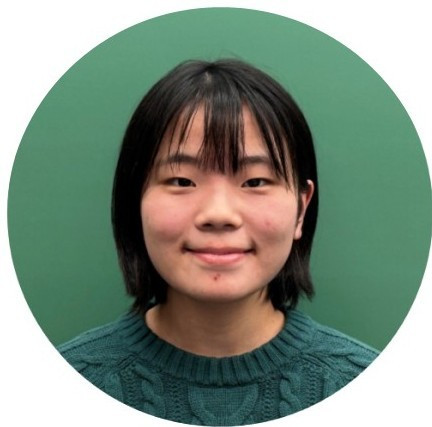 こんにちは、2年生の伊藤 綾音です。このジャーナルを読んでくれている皆さん、突然ですが質問です。「DMG森精機」という会社を知っていますか? 一言で説明すると、世界的に活躍する日本の大手工作機械メーカーです。今回、夏休みの期間中に、私がこのDMG森精機主催の「デジタルものづくり実践講座」に参加してきた内容について報告したいと思います。
こんにちは、2年生の伊藤 綾音です。このジャーナルを読んでくれている皆さん、突然ですが質問です。「DMG森精機」という会社を知っていますか? 一言で説明すると、世界的に活躍する日本の大手工作機械メーカーです。今回、夏休みの期間中に、私がこのDMG森精機主催の「デジタルものづくり実践講座」に参加してきた内容について報告したいと思います。
ではまず「DMG森精機」について。冒頭にも書きましたが、大手工作機械メーカーであり、主に、NC旋盤や5軸加工機、マシニングセンタなどの工作機械を製作・販売を行い、その実用性の高さから世界で活躍する会社です。
そのDMG森精機が開催しているの「デジタルものづくり実践講座」では、最新の工作機械と自動化システムについて学ぶことができます。対象は高専生で、リモート講義や二日間の実習授業を行います。実際に工場で働いているモノホンの工作機械が眼前1㎝……!は言いすぎですが、触れるほど近くで、じっくり観察し放題です。というか本当に触れられます!この講座の醍醐味は、自分の手で操作体験を行えるところですね!
操作体験を行う工作機械は、5軸加工機「DMU50 3rd Generation」です。ドリルと加工を行う材料を、X・Y・Z方向と二つの回転からなる5軸で回し、あらゆる形を作り出します。5軸加工機のドリルは自在に動き回るので、さながらSF映画に出てくるロボットアームのようでした。自分で設定した値の位置にびしっと動き、正確に金属を削ってくれるととても気持ちがいいです。
次に、自動化システムについて……と言いたいところですが、あまりネタバレしすぎるのも面白くないので、続きはぜひ「デジタルものづくり実践講座」で体験してみてください。しかもこの講座、交通費無料!ホテル代無料!全国各地で開催されており、気軽に応募できるのもうれしいところ。実際に製造を行っている会社の方とお話しできる機会だって、そうそうないと思うので本当におすすめです!
以上、DMG森精機潜入レポートでした。
また次の機会に会えることを楽しみにしています。さようなら!
伊藤 綾音
 Hello, this is Ayane ito, a 2nd year student. Let me begin with a quick question — have you ever heard of DMG MORI?
Hello, this is Ayane ito, a 2nd year student. Let me begin with a quick question — have you ever heard of DMG MORI?
In short, DMG MORI is one of Japan’s leading machine tool manufacturers with a strong global presence. My name is Ayane Ito. I am a 2nd year student, and during the summer vacation, I participated in the Digital Manufacturing Hands-on Seminar hosted by DMG MORI during this summer break. I would like to share what the experience was like.
First, a brief introduction to DMG MORI. As mentioned above, it is a major manufacturer of machine tools, and many of you may already be familiar with the name. The company designs and produces tools such as Numerical Control lathes, 5-axis machining centers, and milling machines, which are used worldwide thanks to their outstanding practicality and precision.
The Digital Manufacturing Hands-on Seminar organized by DMG MORI offers participants the opportunity to learn about the latest machine tools and automation systems. The program is open to technical college students and includes both online lectures and a two-day in-person practical session. Participants can observe real, working industrial machines up close — close enough to touch them. For me, the highlight of the program was being able to operate the machines myself.


The machine we used during the workshop was the 5-axis machining center “DMU50 3rd Generation.”
It moves the drill and the workpiece along the X, Y, and Z axes, combined with two rotational axes, to create complex shapes with remarkable precision. The drill head moves freely, almost like a robotic arm straight out of a science fiction film. It was incredibly satisfying to see it move precisely to the programmed coordinates and cut the metal exactly as intended.
As for the automation systems we learned about — I won’t spoil too much here. I highly recommend experiencing it for yourself by joining the Digital Manufacturing Hands-on Seminar. What’s more, participation is free of charge, with transportation and accommodation expenses covered. The seminar is held in various locations across Japan, making it accessible for students nationwide. It is also a valuable opportunity to interact directly with professionals working in the manufacturing industry.
That concludes my inside report on DMG MORI.
Thank you for reading, and I look forward to sharing more next time!
Ayane ito
 こんにちは!白山麓高専事務室の間加田 侑里です。今回は「ハロウィンイベント」について紹介します。
こんにちは!白山麓高専事務室の間加田 侑里です。今回は「ハロウィンイベント」について紹介します。
ハロウィンの季節になると、白山麓キャンパスの校舎は学生とラーニングメンターによってハロウィン仕様に飾り付けが行われます。手作りのジャック・オー・ランタンやエアコン吹き出し口へのイラスト入りビニール袋の貼り付けなど、遊び心あふれるデザインで館内は華やかになりました。
2025年10月31日(金)、ハロウィン当日、数名の学生たちや教員たちはハロウィンの仮装をして授業を行いました。学生たちはポケモンの衣装やメイド服、カウボーイなど、教員は日本の制服やバナナの衣装を身にまとい、ユニークなスタイルで授業が進められました。
昼食にはハロウィン特別メニューが提供され、吸血鬼のごちそうピザ(中にチーズが入っていてとても美味しかったです!)、芋虫の形をした不気味な色のパスタ、さらに約10種類のお菓子が取り放題で並び、学生たちは楽しそうに食事を満喫していました。
授業が終了するとともに、さらに仮装をする学生たちが増えました。馬の被り物をして相撲のコスチュームを着たり、ボディーガードを従えた石油王に扮したり、赤色の洋服をマント風にアレンジして個性的な仮装をしたりと、思い思いのスタイルで登場しました。パレードでは、ステージの上で堂々とポーズを決め、観客を魅了しました。時には笑いが起きたりして終始賑やかな雰囲気で行われました。
その後、ピニャータが行われました。ピニャータとは、メキシコのお祝い事で有名な行事で、くす玉を叩いて割るゲームです。目隠しした学生は周囲の声を参考にしながら前後左右に進み、くす玉を叩き割りました。くす玉に入ったお菓子が飛び散る瞬間は歓声が上がりました。
ハロウィン特別メニュー
また、ラーニングセッション(夜の学校)の時間には「校内かくれんぼ」が開催されました。学生たちは4つのグループに分かれ、各グループが順番に鬼となり、他のグループは隠れます。館内の証明を全て消し、鬼は携帯電話のライトを頼りに隠れている学生を探しました。時間制限が設けられ、鬼は教室や実験室、トイレ、棚の中まで隅々と捜索しました。隠れている学生たちは見つからないよう静かにしていましたが、鬼に見つかった瞬間、思わず叫び声をあげる学生もいました。制限時間内に見つからなかった学生には、勝者としてお菓子がプレゼントされました。
今回のハロウィンイベントは、学生と教員が一体となって楽しむ貴重な機会となりました。校舎全体が季節の雰囲気に包まれ、笑顔が広がる一日でした。
間加田 侑里

Hello! I’m Yuri Makada from the Hakusanroku office. Today, I’d like to introduce this year’s Halloween Events.
As the Halloween season approached, the Hakusanroku campus building was festively decorated by students and learning mentors. They created handmade Jack-o’-lanterns and added playful touches, such as illustrated plastic bags attached to air conditioner vents, brightening up the entire building.
On Friday, October 31st, 2025, the day of Halloween, several students and faculty members attended classes in costume. Students dressed as Pokémon characters, maids, cowboys, and more, while teachers appeared in Japanese school uniforms or even banana costumes, creating a unique and lively atmosphere in the classroom.
For lunch, a special Halloween menu was served such as Vampire’s Feast Pizza (stuffed with cheese and absolutely delicious!), creepy-colored pasta shaped like caterpillars PLUS about 10 varieties of candy available for everyone to enjoy. Students had a great time savoring these treats.
As the classes came to an end, even more students joined in with creative costumes. One student a horse headpiece paired with a sumo outfit, another dressed up as an Arabian sheik accompanied by his bodyguards, and another student transformed ordinary red clothes into cape-like design for unique look. During the Halloween parade, students struck confident poses on stage, captivating the audience. Laughter and cheers filled the atmosphere, making the event lively from start to finish.
After the parade, the learning mentors held a Piñata game, a tradition from Mexican celebrations where participants break a decorated container to release treats. Blindfolded students relied on the voices of their peers to guide them as they swung at the piñata. When the container finally broke and candy scattered everywhere, the room erupted in excitement.
Later, during the Learning Session (Night School), learning mentors hosted a Campus Hide-and-Seek game. Students were divided into four groups, taking turns as “seekers” while the others hid. All the lights in the building were turned off, and seekers used their phone flashlights to search classrooms, labs, restrooms, and even inside shelves. Hidden students tried to stay silent, but some couldn’t help screaming when discovered! Those who remained hidden until the time limit received candy as a prize.
This year’s Halloween event was a wonderful opportunity for students and faculty to come together and have fun. The entire campus was filled with seasonal spirit, and smiles spread through classes, meals, and activities all day long.
Yuri Makada










